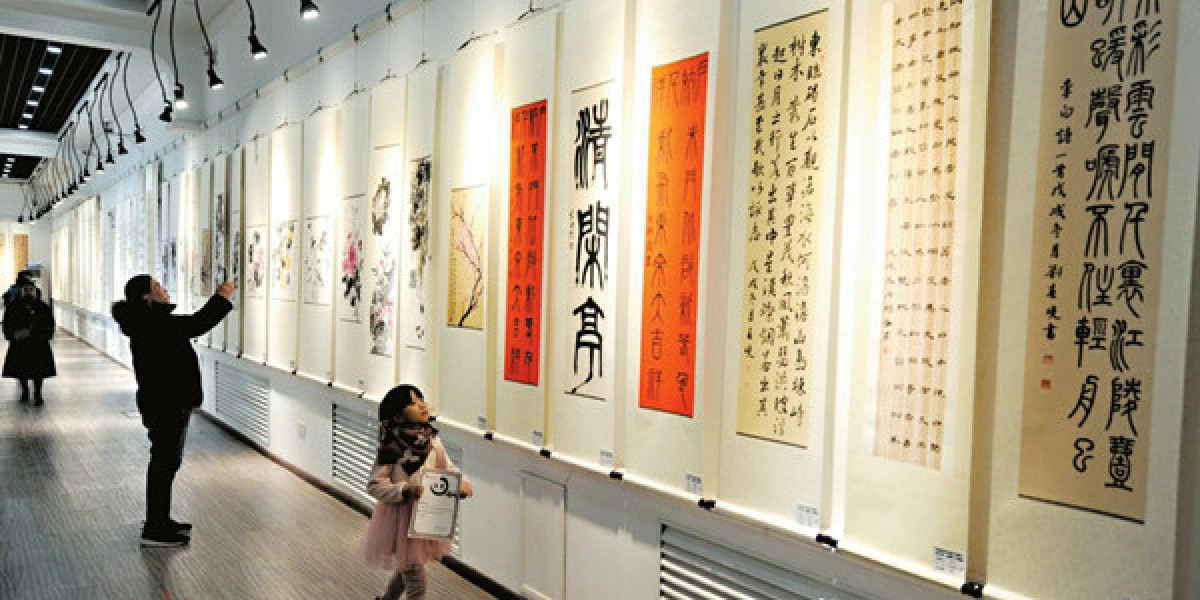Chinese art calligraphy is a highly esteemed form of artistic expression that transcends mere writing. It is often regarded as a reflection of the artist's inner self, embodying not only the beauty of characters but also the philosophical, cultural, and historical context in which it exists. This article delves into the evolution of Chinese art calligraphy, exploring its historical roots, philosophical underpinnings, various styles, and its impact on culture and society.
Historical Roots of Chinese Art Calligraphy
The origins of Chinese calligraphy can be traced back to the ancient Chinese civilization, with its development closely tied to the evolution of the Chinese writing system.
Origins and Early Developments: The earliest evidence of written Chinese dates back to the Shang Dynasty (c. 1600–1046 BCE) with oracle bone script, used for divination purposes. This script laid the groundwork for subsequent writing forms. As the writing system evolved, so did the tools and materials used for writing, including brushes, ink, and paper.
The Qin Dynasty: The unification of China under the Qin Dynasty (221–206 BCE) marked a significant turning point for calligraphy. The First Emperor, Qin Shi Huang, standardized the script, leading to the emergence of the small seal script, which became an important precursor to later styles. This standardization facilitated communication across the vast empire and set the stage for the flourishing of calligraphy.
The Han Dynasty: During the Han Dynasty (206 BCE–220 CE), calligraphy began to gain prominence as an art form. The introduction of paper in the 2nd century CE revolutionized writing, allowing for greater accessibility. The clerical script emerged, characterized by its more practical and legible forms, making it widely used in official documents.
Development of Styles: The subsequent dynasties, particularly the Tang (618–907) and Song (960–1279), saw the flourishing of various calligraphic styles. The Tang Dynasty is noted for its emphasis on the artistic quality of calligraphy, with renowned calligraphers like Wang Xizhi and Yan Zhenqing setting high standards. The Song Dynasty further refined these styles, leading to the development of the regular script, which remains influential to this day.
Philosophical Underpinnings
Chinese art calligraphy is deeply intertwined with Chinese philosophy, particularly Confucianism, Daoism, and Buddhism. These philosophies have shaped the way calligraphy is perceived and practiced.
Confucian Influence: Confucianism emphasizes moral integrity, education, and the cultivation of personal character. Calligraphy is often seen as a reflection of the calligrapher’s virtues and scholarly pursuits. The practice of calligraphy is not merely about creating beautiful characters; it embodies the pursuit of self-cultivation and the expression of moral values.
Daoist Philosophy: Daoism emphasizes harmony with nature and the universe. This philosophy influences the fluidity and spontaneity of calligraphic strokes. Calligraphers often strive to express their connection to the natural world through their brushwork, mirroring the spontaneity found in nature.
Buddhism: The introduction of Buddhism introduced new themes and concepts to Chinese art, including calligraphy. Buddhist texts were often transcribed by skilled calligraphers, emphasizing the spiritual aspect of writing. The act of writing became a meditative practice, allowing artists to express their devotion and understanding of Buddhist teachings.
Styles of Chinese Art Calligraphy
Over the centuries, various styles of Chinese calligraphy have emerged, each with its unique characteristics and historical significance.
Seal Script (篆书): Seal script is one of the oldest forms of Chinese writing, characterized by its ornate and intricate characters. It was commonly used for official seals and inscriptions. This script reflects the beauty of ancient Chinese characters and is often appreciated for its aesthetic value.
Clerical Script (隶书): Emerging during the Han Dynasty, clerical script features more simplified and standardized characters. It is easily legible, making it suitable for official documents. The clerical script represents a bridge between ancient and modern forms of writing.
Regular Script (楷书): Regular script is the most widely used style in contemporary Chinese calligraphy. It is characterized by its clear and standardized strokes, making it accessible for everyday writing. This style combines beauty and practicality, serving as the foundation for modern Chinese typography.
Running Script (行书): Running script is a semi-cursive style that emphasizes fluidity and speed. It allows for a more expressive and dynamic form of writing, often used for personal letters and artistic expression. The running script reflects the calligrapher's individuality and emotional state.
Cursive Script (草书): Cursive script is the most spontaneous and free form of Chinese calligraphy. It often prioritizes expression over legibility, with characters flowing together in a dynamic manner. While it may be difficult to read, cursive script showcases the calligrapher's skill and creativity.
Tools and Techniques
The tools and techniques employed in Chinese art calligraphy play a crucial role in shaping the final work.
Brushes: Traditional Chinese calligraphy uses brushes made from animal hair, typically from weasels, goats, or rabbits. The type of brush influences the quality of strokes, with softer brushes allowing for more fluid and expressive lines.
Ink: Chinese ink is traditionally made from soot and animal glue, often formed into ink sticks that are ground on an ink stone with water. The quality of ink affects the richness and depth of the calligraphy, with various consistencies used for different styles.
Paper: Rice paper and Xuan paper are commonly used in calligraphy. These papers have unique textures and absorbencies that allow for various effects. The choice of paper can significantly impact the final appearance of the calligraphy.
Techniques: Calligraphers employ various techniques, such as controlling brush pressure, angle, and speed, to create different effects. Mastery of these techniques requires years of practice and dedication.
Cultural Impact of Chinese Art Calligraphy
Chinese art calligraphy has had a profound influence on culture and society, shaping not only artistic practices but also social norms and values.
Cultural Identity: Calligraphy is considered one of the highest forms of art in Chinese culture, embodying the aesthetics, philosophy, and history of the civilization. It serves as a symbol of cultural identity and pride, reflecting the continuity of Chinese traditions over millennia.
Education and Scholarship: The study of calligraphy has been an integral part of Chinese education for centuries. Scholars and literati engaged in calligraphy as a means of intellectual cultivation. Mastery of calligraphy is often seen as an indicator of a person's education and refinement.
Influence on Other Art Forms: Calligraphy has influenced various other forms of art, including painting and poetry. Many artists incorporate calligraphic elements into their paintings, creating a harmonious blend of visual and literary expression. The interplay between calligraphy and other art forms enriches the overall cultural landscape.
Ceremonial and Ritual Significance: Calligraphy plays a significant role in various Chinese ceremonies and rituals. It is often used in religious and cultural practices, such as writing auspicious phrases for celebrations or creating banners for festivals. These practices highlight the spiritual and symbolic aspects of calligraphy.
Modern Interpretations of Chinese Calligraphy
In contemporary times, Chinese art calligraphy continues to evolve, reflecting the changing dynamics of society and culture.
Contemporary Artists: Many modern artists are reinterpreting traditional calligraphy, blending it with contemporary themes and styles. This fusion allows for innovative expressions that resonate with modern audiences while honoring the rich heritage of calligraphy.
Globalization: The globalization of art has led to increased interest in Chinese calligraphy beyond its traditional context. Artists and enthusiasts worldwide are exploring calligraphic techniques and styles, leading to cross-cultural exchanges and collaborations.
Digital Calligraphy: The advent of technology has introduced new possibilities for calligraphy. Digital tools and software allow artists to create calligraphic works in virtual environments, expanding the reach of this ancient art form. Digital calligraphy enables experimentation and accessibility, attracting a new generation of artists.
Education and Workshops: The continued interest in Chinese art calligraphy has led to the establishment of workshops and classes, both in China and internationally. These programs aim to preserve traditional techniques while encouraging creativity and personal expression among participants.
Conclusion
Chinese art calligraphy is a profound and multifaceted form of expression that has evolved over thousands of years. Its historical roots, philosophical underpinnings, and diverse styles illustrate the depth of Chinese culture and the enduring significance of this art form.
As Chinese art calligraphy continues to adapt and thrive in contemporary society, it remains a vital expression of identity, creativity, and cultural heritage. By understanding its evolution and impact, one can appreciate the intricate relationship between calligraphy and the broader tapestry of Chinese art and civilization. This exploration of Chinese art calligraphy not only honors its historical legacy but also invites a continued appreciation for its beauty and relevance in the modern world.








